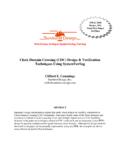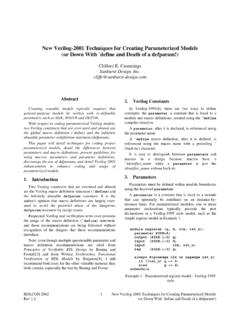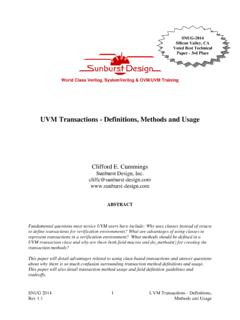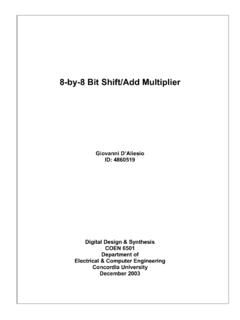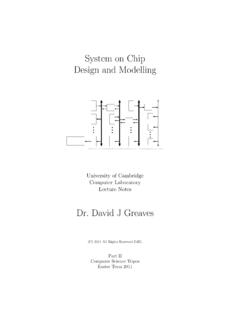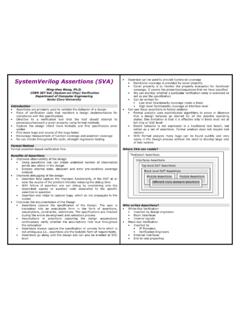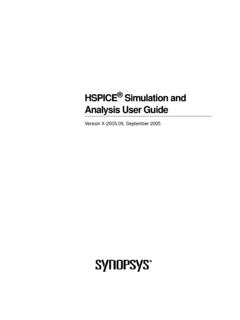Transcription of Synchronous Resets? Asynchronous Resets ... - Sunburst …
1 Synchronous Resets ? Asynchronous Resets ?I am so confused!How will I ever know which to use?Clifford E. CummingsDon MillsSunburst Design, EngineeringABSTRACTThis paper will investigate the pros and cons of Synchronous and Asynchronous Resets . It will then look at usage ofeach type of reset followed by recommendations for proper usage of each paper will also detail an interesting synchronization technique using digital calibration to synchronize resetremoval on a multi-ASIC San Jose 2002 Synchronous Resets ? Asynchronous Resets ?Rev am so confused! How will I ever know which to use? Resets , Resets , Resets , and then there s RESETSOne cannot begin to consider a discussion of reset usage and styles without first saluting the most common resetusage of all. This undesired reset occurs almost daily in systems that have been tested, verified, manufactured, andintegrated into the consumer, education, government, and military environments. This reset follows what is oftencalled The Blue Screen of Death resulting from software incompatibilities between the OS from a certain softwarecompany, the software programs the OS is servicing, and the hardware on which the OS software is be concerned with these annoying little Resets anyway?
2 Why devote a whole paper to such a trivial subject?Anyone who has used a PC with a certain OS loaded knows that the hardware reset comes in quite handy. It will putthe computer back to a known working state (at least temporarily) by applying a system reset to each of the chips inthe system that have or require a individual ASICs, the primary purpose of a reset is to force the ASIC design (either behavioral, RTL, orstructural) into a known state for simulation . Once the ASIC is built, the need for the ASIC to have reset applied isdetermined by the system, the application of the ASIC, and the design of the ASIC. For instance, many data pathcommunication ASICs are designed to synchronize to an input data stream, process the data, and then output it. Ifsync is ever lost, the ASIC goes through a routine to re-acquire sync. If this type of ASIC is designed correctly, suchthat all unused states point to the start acquiring sync state, it can function properly in a system without ever beingreset.
3 A system reset would be required on power up for such an ASIC if the state machines in the ASIC tookadvantage of don t care logic reduction during the synthesis is the opinion of the authors that in general, every flip-flop in an ASIC should be resetable whether or not it isrequired by the system. Further more, the authors prefer to use Asynchronous Resets following the guidelines detailedin this paper. There are exceptions to these guidelines. In some cases, when follower flip-flops (shift register flip-flops) are used in high speed applications, reset might be eliminated from some flip-flops to achieve higherperformance designs. This type of environment requires a number of clocks during the reset active period to put theASIC into a known design issues must be considered before choosing a reset strategy for an ASIC design, such as whether to usesynchronous or Asynchronous Resets , will every flip-flop receive a reset, how will the reset tree be laid out andbuffered, how to verify timing of the reset tree, how to functionally test the reset with test scan vectors, and how toapply the reset among multiple clock addition, when applying Resets between multiple ASICs that require a specific reset release sequence, specialtechniques must be employed to adjust to variances of chip and board manufacturing.
4 The final sections of thispaper will address this latter General flip-flop coding style Synchronous reset flip-flops with non reset follower flip-flopsEach Verilog procedural block or VHDL process should model only one type of flip-flop. In other words, a designershould not mix resetable flip-flops with follower flip-flops (flops with no Resets )[12]. Follower flip-flops are flip-flops that are simple data shift the Verilog code of Example 1a and the VHDL code of Example 1b, a flip-flop is used to capture data and then itsoutput is passed through a follower flip-flop. The first stage of this design is reset with a Synchronous reset. Thesecond stage is a follower flip-flop and is not reset, but because the two flip-flops were inferred in the sameprocedural block/process, the reset signal rst_n will be used as a data enable for the second flop. This coding stylewill generate extraneous logic as shown in Figure San Jose 2002 Synchronous Resets ? Asynchronous Resets ?Rev am so confused!
5 How will I ever know which to use?3module badFFstyle (q2, d, clk, rst_n); output q2; input d, clk, rst_n; reg q2, q1; always @(posedge clk) if (!rst_n) q1 <= 1'b0; else begin q1 <= d; q2 <= q1; endendmoduleExample 1a - Bad Verilog coding style to model dissimilar flip-flopslibrary ieee;use ;entity badFFstyle is port ( clk : in std_logic; rst_n : in std_logic; d : in std_logic; q2 : out std_logic);end badFFstyle;architecture rtl of badFFstyle is signal q1 : std_logic;begin process (clk) begin if (clk'event and clk = '1') then if (rst_n = '0') then q1 <= '0'; else q1 <= d; q2 <= q1; end if; end if; end process;end rtl;Example 1b - Bad VHDL coding style to model dissimilar flip-flopsFigure 1 - Bad coding style yields a design with an unnecessary loadable flip-flopSNUG San Jose 2002 Synchronous Resets ? Asynchronous Resets ?Rev am so confused! How will I ever know which to use?4 The correct way to model a follower flip-flop is with two Verilog procedural blocks as shown in Example 2a or twoVHDL processes as shown in Example 2b.
6 These coding styles will generate the logic shown in Figure goodFFstyle (q2, d, clk, rst_n); output q2; input d, clk, rst_n; reg q2, q1; always @(posedge clk) if (!rst_n) q1 <= 1'b0; else q1 <= d; always @(posedge clk) q2 <= q1;endmoduleExample 2a - Good Verilog coding style to model dissimilar flip-flopslibrary ieee;use ;entity goodFFstyle is port ( clk : in std_logic; rst_n : in std_logic; d : in std_logic; q2 : out std_logic);end goodFFstyle;architecture rtl of goodFFstyle is signal q1 : std_logic;begin process (clk) begin if (clk'event and clk = '1') then if (rst_n = '0') then q1 <= '0'; else q1 <= d; end if; end if; end process; process (clk) begin if (clk'event and clk = '1') then q2 <= q1; end if; end process;end rtl;Example 2b - Good VHDL coding style to model dissimilar flip-flopsSNUG San Jose 2002 Synchronous Resets ? Asynchronous Resets ?Rev am so confused! How will I ever know which to use?
7 5 Figure 2 - Two different types of flip-flops, one with Synchronous reset and one withoutIt should be noted that the extraneous logic generated by the code in Example 1a and Example 1b is only a result ofusing a Synchronous reset. If an Asynchronous reset approach had be used, then both coding styles would synthesizeto the same design without any extra combinational logic. The generation of different flip-flop styles is largely afunction of the sensitivity lists and if-else statements that are used in the HDL code. More details about thesensitivity list and if-else coding styles are detailed in section Flip-flop inference styleEach inferred flip-flop should not be independently modeled in its own procedural block/process. As a matter ofstyle, all inferred flip-flops of a given function or even groups of functions should be described using a singleprocedural block/process. Multiple procedural blocks/processes should be used to model macro level functionaldivisions within a given module/architecture.
8 The exception to this guideline is that of follower flip-flops asdiscussed in the previous section (section ) where multiple procedural blocks/processes are required to efficientlymodel the function Assignment operator guidelineIn Verilog, all assignments made inside the always block modeling an inferred flip-flop (sequential logic) should bemade with nonblocking assignment operators[3]. Likewise, for VHDL, inferred flip-flops should be made usingsignal Synchronous resetsAs research was conducted for this paper, a collection of ESNUG and SOLV-IT articles was gathered and 80+% of the gathered articles focused on Synchronous reset issues. Many SNUG papers have beenpresented in which the presenter would claim something like, we all know that the best way to do Resets in an ASICis to strictly use Synchronous Resets , or maybe, Asynchronous Resets are bad and should be avoided. Yet, littleevidence was offered to justify these statements. There are some advantages to using Synchronous Resets , but thereare also disadvantages.
9 The same is true for Asynchronous Resets . The designer must use the approach that isappropriate for the Resets are based on the premise that the reset signal will only affect or reset the state of the flip-flop onthe active edge of a clock. The reset can be applied to the flip-flop as part of the combinational logic generating thed-input to the flip-flop. If this is the case, the coding style to model the reset should be an if/else priority stylewith the reset in the if condition and all other combinational logic in the else section. If this style is not strictlyobserved, two possible problems can occur. First, in some simulators, based on the logic equations, the logic canblock the reset from reaching the flip-flop. This is only a simulation issue, not a hardware issue, but remember, oneof the prime objectives of a reset is to put the ASIC into a known state for simulation . Second, the reset could be a late arriving signal relative to the clock period, due to the high fanout of the reset tree.
10 Even though the reset willbe buffered from a reset buffer tree, it is wise to limit the amount of logic the reset must traverse once it reaches thelocal logic. This style of Synchronous reset can be used with any logic or library. Example 3 shows animplementation of this style of Synchronous reset as part of a loadable counter with carry San Jose 2002 Synchronous Resets ? Asynchronous Resets ?Rev am so confused! How will I ever know which to use?6module ctr8sr ( q, co, d, ld, rst_n, clk); output [7:0] q; output co; input [7:0] d; input ld, rst_n, clk; reg [7:0] q; reg co; always @(posedge clk) if (!rst_n) {co,q} <= 9'b0; // sync reset else if (ld) {co,q} <= d; // sync load else {co,q} <= q + 1'b1; // sync incrementendmoduleExample 3a - Verilog code for a loadable counter with Synchronous resetlibrary ieee;use ;use ;entity ctr8sr is port ( clk : in std_logic; rst_n : in std_logic; d : in std_logic; ld : in std_logic; q : out std_logic_vector(7 downto 0); co : out std_logic);end ctr8sr;architecture rtl of ctr8sr is signal count : std_logic_vector(8 downto 0);begin co <= count(8); q <= count(7 downto 0); process (clk) begin if (clk'event and clk = '1') then if (rst_n = '0') then count <= (others => '0'); -- sync reset elsif (ld = '1') then count <= '0' -- sync load else count <= count + 1; -- sync increment end if; end if; end process;end rtl.






